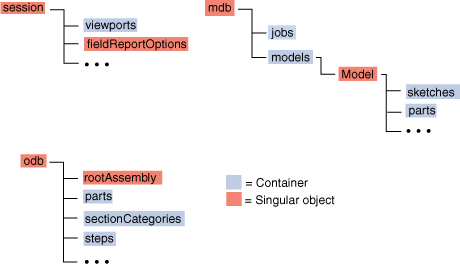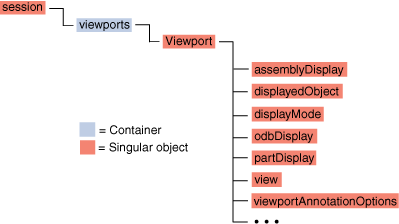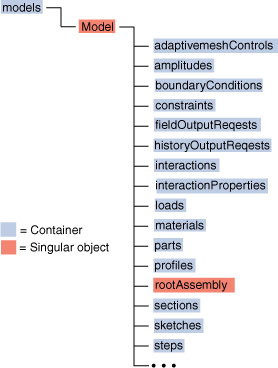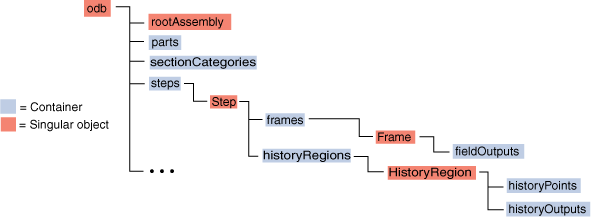About the Abaqus object model | ||
| ||
-
A definition of each Abaqus Scripting Interface object including its methods and data members. The object definitions are found in the Abaqus Scripting Reference Guide.
-
Definitions of the relationships between the objects. These relationships form the structure or the hierarchy of the object model. The relationships between the objects are summarized in the following list:
- Ownership
-
The ownership hierarchy defines the access path to the objects in the Abaqus model.
- Associations
-
Associations describe the relationships between the objects; for example, whether one object refers to another and whether an object is an instance of another.
Abaqus extends Python with approximately 500 additional objects, and there are many relationships between these objects. As a result, the complete Abaqus object model is too complex to illustrate in a single figure.
In general terms the Abaqus object model is divided into the Session, the Mdb, and the Odb objects, as shown in Figure 1.

An object in the object model can be one of the following:
- Container
-
A Container is an object that contains objects of a similar type. A container in the Abaqus object model can be either a repository or a sequence. For example, the steps container is a repository that contains all the steps in the analysis. Your scripts use the steps container to access a step.
- Singular object
-
Objects that are not containers are shown as a Singular object. A singular object contains no other objects of a similar type; for example, the Session object and the Mdb object. There is only one Session object and only one Mdb object in the Abaqus object model.
The ... at the end of the object models shown in this section indicates that there are additional objects in the model that are not included in the figure. For clarity, the figures show only the most commonly used objects in the object model.
The statement from abaqus import * imports the Session object (named session) and the Mdb object (named mdb) and makes them available to your scripts. The statement from odbAccess import * allows you to access Abaqus output results from your script. The Session, Mdb, and Odb objects are described as follows:
- Session
-
Session objects are objects that are not saved between Abaqus/CAE sessions; for example, the objects that define viewports, remote queues, and user-defined views, as shown in Figure 2.
Figure 2. The Session object model.
The viewports container is owned by the Session object, as shown in Figure 3.
Figure 3. The Viewport object model.
- Mdb
-
The statement from abaqus import * creates an instance of the Mdb object called mdb. Mdb objects are objects that are saved in a model database and can be recovered between Abaqus/CAE sessions. Mdb objects include the Model object and the Job object. The Model object, in turn, is comprised of Part objects, Section objects, Material objects, Step objects, etc. Figure 4 shows the basic structure of the objects under the Model object. For more information, see The Model object model.
Figure 4. The structure of the objects under the Model object.
- Odb
-
Odb objects are saved in an output database and contain both model and results data, as shown in Figure 5.
Figure 5. The Odb object model.
Most of the commands in the Abaqus Scripting Interface begin with either the Session, the Mdb, or the Odb object. For example,
session.viewports['Viewport-1'].bringToFront() mdb.models['wheel'].rootAssembly.regenerate() stress = odb.steps['Step-1'].frames[3].fieldOutputs['S']